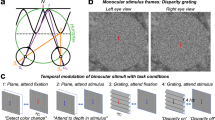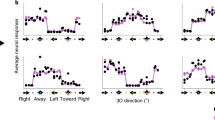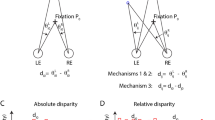Abstract
When people get new glasses, they often experience distortions in the apparent three-dimensional layout of the environment; the distortions fade away in a week or so. Here we asked observers to wear a horizontal magnifier in front of one eye for several days, causing them to initially perceive large three-dimensional distortions. We found that adaptation to the magnifier was not caused by changes in the weights given to disparity and texture, or by monocular adaptation, but rather by a change in the mapping between retinal disparity and perceived slant.
This is a preview of subscription content, access via your institution
Access options
Subscribe to this journal
Receive 12 print issues and online access
$209.00 per year
only $17.42 per issue
Buy this article
- Purchase on Springer Link
- Instant access to full article PDF
Prices may be subject to local taxes which are calculated during checkout



Similar content being viewed by others
References
Clark, J. J. & Yuille, A. L. Data Fusion for Sensory Information Processing Systems (Kluwer, Boston, Massachusetts, 1990).
Landy, M. S. et al. Vision Res. 35, 389–412 (1995).
Ogle, K. N. Researches in Binocular Vision (Saunders, Philadelphia, Pennsylvania, 1950).
Burian, H. M. Arch. Ophthalmol. 30, 645–666 (1943).
Remole, A. Clin. Experiment. Optom. 74, 71–79 (1991).
Burian, H. M. & Ogle, K. N. Am. J. Ophthalmol. 28, 735–743 (1945).
Morrison, L. C. Br. J. Physiol. Opt. 27, 84–101 (1972).
Miles, P. W. Am. J. Ophthalmol. 36, 687–696 (1948).
Epstein, W. & Morgan, C. L. Am. J. Psychol. 83, 322–329 (1970).
Epstein, W. & Morgan-Paap, C. L. J. Exp. Psychol. 102, 585–594 (1974).
Epstein, W. & Davies, N. Percept. Psychophys. 12, 315–317 (1972).
Rock, I. The Nature of Perceptual Adaptation (Basic, New York, 1966).
Backus, B. T., Banks, M. S., van Ee, R. & Crowell, J. A. Vision Res. 39, 1143–1170 (1999).
Backus, B. T. & Banks, M. S. Perception 28, 217–242 (1999).
Acknowledgements
Supported by NSF (DBS-9309820), AFOSR (93NL366), NIH (T32 EY07043-21), and Royal Netherlands Academy. We thank M. Landy for discussions, G. Lee for advice on lens manufacturing, and all participants.
Author information
Authors and Affiliations
Corresponding author
Rights and permissions
About this article
Cite this article
Adams, W., Banks, M. & van Ee, R. Adaptation to three-dimensional distortions in human vision. Nat Neurosci 4, 1063–1064 (2001). https://doi.org/10.1038/nn729
Received:
Accepted:
Published:
Issue Date:
DOI: https://doi.org/10.1038/nn729
This article is cited by
-
Do observers use their own interpupillary distance in disparity scaling?
Optical Review (2023)
-
Influence of the Foliar Applications of Paclobutrazol and 24-Epibrassinolide on the Quantitative and Qualitative Traits of Sage (Salvia officinalis L.) Volatile Oil Under Different Soil Moisture Conditions
Journal of Plant Growth Regulation (2023)
-
Proscription supports robust perceptual integration by suppression in human visual cortex
Nature Communications (2018)
-
Orientation-specific learning of the prior assumption for 3D slant perception
Scientific Reports (2018)
-
Effects of astigmatic axis orientation on postural stabilization with stationary equilibrium
Optical Review (2018)



